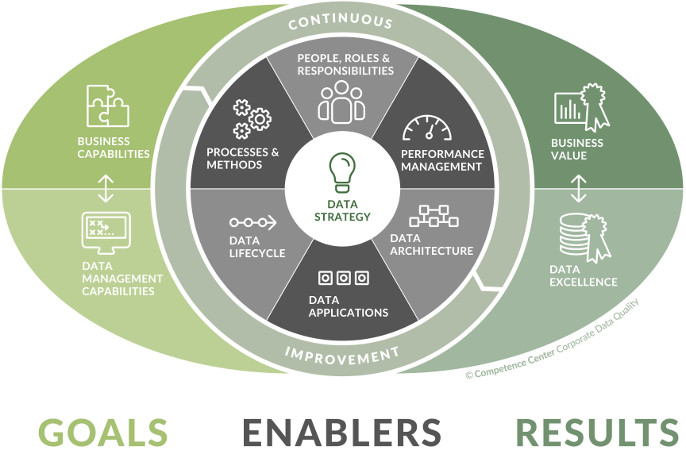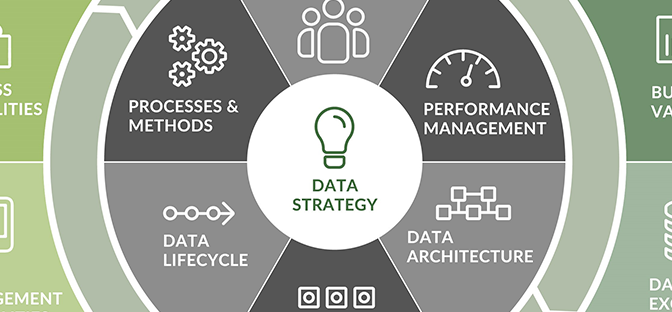In this Q&A, Christine Legner talks about the Competence Center Corporate Data Quality (CC CDQ), the data excellence model that the consortium has produced, and the need for organisations to think about data and its management in new ways, as many corporations engage in the digital transformation of their business.
What was the thinking behind setting up the Center?
Although data is increasingly a competitive factor in the digital economy, most firms do not yet manage it in the same way as other corporate resources. Poor data quality and information silos are some common problems encountered, for example. The Center addresses this issue by developing strategies, methods and tools for corporate data management. Effectively we provide an expert community and knowledge sharing platform to bridge the gap between theory and practice. A very important aspect of the Centre is the close relationship between our academic research capability – we have a research team with five PhDs from the Universities of Lausanne and St. Gallen – and our 20 industry partners. This allows us to follow an iterative innovation cycle where we can move between innovative research, and prototype and pilot testing in the real world.
Is the new Data Excellence Model a product of that innovation cycle?
Yes. Our industry partners asked us to support them as they develop into digital and data driven enterprises. The Data Excellence Model guides them in (re-)defining their data strategy and building the organizational and technical foundations for managing data. The development process took over 15 months, during this time the framework was developed collaboratively between academics and practitioners. It also builds on an earlier version of the model which was originally created ten years ago and has been tested in many companies.
Why do we need to rethink data management?
In the past, corporate data management was mostly about data quality and so-called master data, for example customer or product data. This data is critical for integrating and harmonizing business processes or for selling on online channels. Today, companies have to deal with “big data” – vast amounts of data from a large number of internal and external sources – and some of them create new data-driven business models. As more data is directly generated and collected from customers, concerns about data security and privacy become an issue. Companies have to treat data in an ethical way and comply with an increasing number of data-related regulations, for example the Global Data Protection Regulation that becomes effective next year in Europe.
Would it be correct to say that this has a lot to do with the changing role of data for companies, which is reflected by the changes in the kinds of work that you have been undertaking at the Centre?
Well originally, when the Competence Centre was set up 10 years ago, it was as a result of e-business research we had been doing. Every e-shop or customer portal initiative that we were involved in required some large data clean-up projects, but problems continued because data governance and architecture was lacking. So we started off addressing data quality.
But the role of data has changed from then. In the last few years data has become really business critical as organisations have engaged in digital transformation initiatives. We’ve seen organisations looking to leverage the use of data with trends such as Industry 4.0, the internet of things and big data, for example.
Can you give me an example of how data is being used in new ways?
Smart products are a good example. Imagine a company that makes sports equipment, such as soccer balls. As they go digital, they integrate a sensor which collects data and then they suggest a mobile app that allows you to analyse and improve the way that you kick the ball. To enter into the smart products market you need to be able to collect and process vast amounts of sensor data, to connect it to customer and contract information, and to handle the data involved properly. While we don’t help companies decide on what products they want to offer, we can and do help them with managing the data and using it in a way that enables them to support the business capabilities that they want to develop.
And your framework moves beyond how organisations have traditionally dealt with data?
Yes. In the past you have had people in organisations with job titles such as head of master data or enterprise information management. Increasingly, however, we see the role of the chief data officer (CDO) being discussed. These chief data officers should be responsible for all types of data, not just master data, and help companies to get more value out of their data. We have moved beyond simply governing data, now organisations need to relate data to business objectives.
In the “hype” about big data and industry 4.0, you hear very naïve statements and many companies now strive for gathering as much data as they can. But what do they want to do with the data that they gather or produce? Are they able to get actionable insights to enable fast decision-making or to enrich their products and services? The ways in which organisations are using data involves understanding what types of information products or services are intended, what are the business capabilities that the data is serving. While at the same time considering that new data management capabilities are required to facilitate those capabilities. For example, processing raw mass data to obtain useful management insights will not only require data scientists and data engineers, but also data-savvy employees in marketing, supply chain management or accounting. People that are able to analyse big data and are proficient in the appropriate tools and methodologies have to work together with those who are able to interpret and use the data.
Assembling the data management capabilities is not going to happen by itself – it requires a Chief Data Officer and an organization to support them.

So if I am a senior executive in an organisation undergoing or contemplating digital transformation, and as part of that data is fundamental to succeeding in my core business offering, I need to consider all the elements of your data excellence model?
If you do it will help you to identify and clarify your strategic business objectives associated with data, understand and assess the data related aspects of the business that enable you to achieve those objectives, and obtain the desired results. The previous model largely addressed the enablers – and provided a toolbox for data managers covering mainly data governance and architecture. The revised model includes the goals and results elements.
So, for example, look at “business value” under results. Today we know the value of most things we have in an organisation from the office chairs to the brand value, but what are the data assets worth? And then “data excellence”. Not so long ago that would have mostly been about data quality, but it is a broader topic now that includes factors such as data protection and compliance, for example.
A better understanding of the business relevance and impact of data allows managers to discuss the data challenge with their colleagues elsewhere in the organisation, whether that is in marketing or operations, for example, in terms that those colleagues can relate to.
We don’t have time for an in-depth discussion of the framework here (for those who want to find out more, further details are provided at the end of this interview). Setting that aside – what point could organisations start from on the model
People who are leading digital transformation in companies start from the left hand side and look at use cases. Often they have initiatives and they want to do data driven marketing or smart products or predictive maintenance in industry 4.0, but they do not have a precise idea what they need for this. This means that they have to understand how their business objectives translate into concrete data management capabilities. It is a more strategic level initially, in order to define the data strategy and identify the required organization and architecture.
Or you could start with the right hand side of the mode using business issues caused by poor data quality faced by the organisation. Maybe you lose online sales opportunities because of your poor product data, or you do not have up-to-data customer information, or you are not fully compliant with upcoming regulation, for example – as a driver for a data initiative.
From your experience, in this new data environment, what areas often present a challenge for organisations?
One area that is a challenge is the data lifecycle. Today you are trying to achieve a lot of different but linked objectives with the data. You want to be able to optimise your logistics with good data, to be able to listen and react to customer feedback, to be proactive in reaching the customer. In the past, and it still is the case in many organisations, systems were in silos – CRM systems, operational systems. But today all the data has to be linked, both internally and with external data sources, such as those from social media channels, for example.
This is a challenge. Being able to understand that, from the very early phases of product or service development, to producing that product or service, through delivery, marketing and sales, we have to identify and agree on core data assets and align them across the product or service lifecycle.
So that would mean that each object relevant to your business, including each product or customer, has its own data lifecycle then?
Yes, and you see that already. Think about developing a new car. The team that do the conceptual design work may think in terms of product features, materials, the external appearance and other aspects of design. The engineers may think about materials, components, performance, servicing, costs and other engineering aspects. The marketing and sales team think about customer segments, marketing channels, pricing, brand features. A purchaser would think about the product in terms of parts and components, purchasing contracts and vendors.
Often in organisations there are situations where people are working towards similar objectives but from very different and diverse perspectives. Ideally you would want a single source of truth for each business object – a product or customer – which can then be distributed to and accessed by all those who can contribute towards maximising that value stream.
This is definitely a challenge for organisations, but in order to make sense of “big data” companies have to create a shared understanding of business objects and link them to the data collected via sensors or social networks.
Of course data is essentially its own value stream in a business. How do organisations ensure that they get the appropriate data expertise across their ecosystems?
So a traditional view was, perhaps, that data management needs central coordination and a presence or an expert in each functional unit such as marketing, finance, and so on. However, as data becomes omnipresent, employees have to be “data literate” and know how to find data and work with it. Data managers work with people in the functional areas of the organisation and educate them in data best practice.
This approach makes sense in a digital transformation landscape. In large global organisation there may be thousands of people worldwide that want access to data. Our partner companies define data-related roles and career paths, including different levels of training and certification. We have therefore started to propose executive training to bring new hires up to speed, but to also educate data managers.
So you are saying that setting up experts in a data management department silo and telling them that they are in charge of data management is the wrong approach?
Exactly. As data is created and used throughout the organization, you define data owners in the different functions. This means, for example, that people responsible for customer related data will be close to those customers. Typically you will have a high level of collaboration between a central data management unit that defines the data strategy, processes and methods and the people in the different business units and functional areas.
As I said you cannot delegate the task of leveraging the value of data to one unit, you need excellent engagement with all the various stakeholders in the company, on the business as well as on the IT side.
So just to recap – If I use the model effectively what does it enable me to do as an organisation?
It ensures that you are able to successfully transform into a digital and data-driven company and thus realise new business opportunities because your data will be fit for purpose that you define. So if you want to offer smart products, for example, then you have the related data management capabilities in place and you have a higher business value, because you will be increasing product revenues.
Typically the way organisations get engaged with the model will be that there is a problem or challenge or they are feeling some pain as an organisation as they realise that you need a new approach to data if you want to succeed in a digitally transformed business world.
However, when the organisation is immersed in fast moving innovation cycles, senior managers often do not want to contemplate addressing the data management issues, as they know it will take time. But the longer they take, the more they will struggle with inaccurate or inaccessible data. The more catching up they will have to do both with the digital pioneers, and the traditional incumbents in their markets who are further along the track in terms of successfully creating a digital business.
Useful links:
- Competence Center Corporate Data Quality: http://cc-cdq.ch/
- Overview of Data Excellence Model: https://cc-cdq.ch/data-excellence-model
Related research paper: Pentek, T., Legner, C., Otto, B. (2017): Towards a Reference Model for Data Management in the Digital Economy, in: Proceedings of the 12th International Conference on Design Science Research in Information Systems and Technology (DESRIST 2017), Karlsruhe, Germany.
Featured image by Competence Center Corporate Data Quality (CC CDQ)




